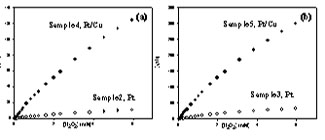Nanoscience: importance does not lie on nobility

The field of metallic nanoparticles (MNP), one of the nanoscience fields with most projection, advances daily. The exceptional characteristic physical and chemical properties of these particles make it possible to use them in electrochemical applications. However, this can be affected by the tendency of MNPs to group together and thus lose their original form. By stabilising the particles in polymeric matrices it is possible not only to control their size and speed of growth, but to store them in solid and liquid forms due to the solubility of polymers. As explained in the following article, noble metals (monometallic particles) are used in electrochemical applications, which make the process extremely expensive. The objective therefore is to reduce the quantity of noble metal used -without compromising electrocatalytic capacity -and add core-shell (bimetallic) nanoparticles. These possess a more economical metal core covered by a noble metal shell. They have been proved to be more stable in both size and shape, and display greater electrocatalytic activity.
Metal nanoparticles (MNPs) represent one of the hottest topics in modern nanoscience and nanotechnology due to their unique physical and chemical properties. However, without stabilization MNPs present a strong trend for aggregation, and this is their main drawback, which still limits in many instances their practical application in various fields. Stabilization of MNPs in polymeric matrices is one possible route to solve this problem. Stabilization of MNPs in polymeric matrices allows one not only to prevent their aggregation but also to control the particle sizes and the rate of their growth. Stabilization of MNPs using soluble polymers also permits one to produce a sort of PSMNP ink by dissolution of the corresponding polymer–metal nanocomposite in an appropriate solvent. The main advantage of the use of soluble polymers for the inter-matrix synthesis (IMS) in comparison with insoluble (e.g. crosslinked) ones is the ease of further processing of the polymer-metal nanocomposite as the ink can be easily deposited on the surface of a corresponding support. After preparation of PSMNPs, they can be stored in the form of either solid polymer–metal nanocomposites or PSMNP inks. However, essentially no data on the stability of MNP solutions can be found in the literature.
MNPs of platinum group metals (PGMs) find wide applications in various catalytic and electrocatalytic processes. The most important problem to be solved in many instances to make these processes more economically feasible is to decrease the PGM loading without markedly changing the catalyst activity. One of the possible solutions of this problem is the use of core–shell PSMNPs, which are composed of a low-cost metal core (e.g., Cu) coated with a noble metal shell (e.g., Pt).
Figure 1. TEM images of Cu- (a), Pt- (b) and Pt/Cu-PSMNP (c) synthesized inside SPEEK stabilizing matrix by IMS technique. HRTEM images of Pt- (d) and Pt/Cu-PSMNPs (e.
In this paper we report the IMS and characterization of monometallic (Pt) and bimetallic (Pt/Cu) core–shell PSMNPs in sulfonated poly(ether ether ketone) (SPEEK) matrices at identical values of Pt loading. Transmission Electron Microscopy (TEM) images show that Cu- and Pt/Cu nanoparticles are of nearly spherical shape and with the diameters of 3–7 nm, while Pt-PSMNPs are absolutely irregular and their size is far bigger than that of Cu-PSMNPs and Pt/Cu-PSMNPs (Fig.1). The results of electrochemical detection of H2O2concentration using amperometric sensors of Graphite Epoxy Composite Electrodes (GECE) modified with MNP-containing membranes demonstrate that, at the same Pt content, the electrocatalytic activity of Pt/Cu-PSMNPs is far higher than that of monometallic Pt-PSMNPs (Fig.2). It has been also demonstrated that polymer–metal nanocomposite inks are stable for a long period of time under room temperature.
References
Synthesis, stability and electrocatalytic activity of polymer-stabilized monometallic Pt and bimetallic Pt/Cu core-shell nanoparticles. Muraviev, DN; Macanás, J; Ruiz, P; Muñoz, M. PHYSICA STATUS SOLIDI A-APPLICATIONS AND MATERIALS SCIENCE, 205 (6): 1460-1464 JUN 2008


